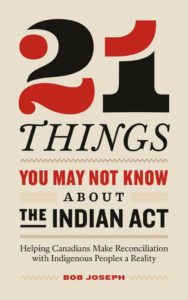Book review: 21 Things You May Not Know About the Indian Act
Reviewed by Karl Hele
Bob Joseph’s 21 Things You May Not Know About the Indian Act: Helping Canadians Make Reconciliation with Indigenous Peoples a Reality is an examination of how the Indian Act has affected First Nations since its creation in 1876. Joseph’s inspiration for writing the book comes from his role as a person who provides training on Indigenous issues. He created the book in an effort to provide Canadians with some knowledge about the Indian Act and its effects in an effort to forward the ultimate goal of reconciliation. To this end, the book is divided into two sections. The first section examines the origins and 21 key policies that are derived from the Indian Act. His second section offers a few suggestions on how to dismantle the Indian Act while seeing First Nations assume self-government and self-determination as key to building better futures for our peoples. These sections are followed by five appendices that provide a glossary of terms, Truth and Reconciliation Commission of Canada (TRC) recommendations, quotations from Sir John A. Macdonald and D. C. Scott, a chronology of residential schools, as well as a guide for some classroom activities. Overall, the work is a summary of policy directed at individuals with little to no knowledge of the Indian Act and its overall effects on First Nations peoples and communities.
in an effort to forward the ultimate goal of reconciliation. To this end, the book is divided into two sections. The first section examines the origins and 21 key policies that are derived from the Indian Act. His second section offers a few suggestions on how to dismantle the Indian Act while seeing First Nations assume self-government and self-determination as key to building better futures for our peoples. These sections are followed by five appendices that provide a glossary of terms, Truth and Reconciliation Commission of Canada (TRC) recommendations, quotations from Sir John A. Macdonald and D. C. Scott, a chronology of residential schools, as well as a guide for some classroom activities. Overall, the work is a summary of policy directed at individuals with little to no knowledge of the Indian Act and its overall effects on First Nations peoples and communities.
21 Things You May Not Know About the Indian Act that Joseph has written about are: (1) the imposition of elected councils; (2) denial of status to women; (3) establishment of reserves; (4) voluntary and forced enfranchisement; (5) expropriation of reserve lands; (6) giving Indians Christian names; (7) establishment of a permit system to sell farm produce; prohibitions on (8) ammunition and (9) liquor sales; (10) declaration of cultural ceremonies as illegal; (11) the imposition of the pass system and (12) residential schools; (13) banning of speaking our languages; (14) banning of western Indians from appearing in shows; (15) leasing of lands to Settlers; (16) banning from organizing political associations; (17) prohibition on raising funds to hire lawyers; (18) prohibition on entering pool halls; (19) prohibition on Indian students from practicing traditional ceremonies; and (20) the barring of the right to vote; as well as (21) how the Indian Act was a piece of legislation designed to subjugate an entire people. Each of the 21 pieces is tied together via specific sections of the Indian Act or through the effects of those sections. Joseph ably illustrates that the overall theme of the Indian Act was to destroy First Nations while remoulding us into the image of Settler society. The judicious use of quotations from historical figures and contemporary politicians, reports, and activists are deftly woven into the text to show the intent, effect, and impact of the policies on individuals and entire communities. This effectively shows the reader that the Indian Act was and remains an odious piece of legislation that needs to be done away with.
The second section, unfortunately, is very short. It is here that Joseph emphasizes self-government and self-determination as the path forward. He acknowledges that one must know the past to progress. Yet, by not offering any thoughts on how to preserve or expand our sovereignty over a land base, Joseph missed an opportunity. Essentially, self-government and self-determination are not always tied to a secure land base by various governmental actors. According to the first section of his book, the Indian Act was also about destroying our land base. Hence, he needs to tie the dismantling of the Indian Act to sovereignty over lands and to self-determination. Additionally, in this section, he promotes the controversial idea of taxation of income, lands, and business by newly reformulated band governments. This is very controversial and needed to be acknowledged as such particularly since taxation of land was a method used to take Indian held lands.
Nevertheless, these quibbles do not detract from the importance of reading 21 Things You May Not Know About the Indian Act to learn about the policies, laws, and overall impacts on First Nations. It is an excellent place to begin to approach reconciliation by broadening one’s mind and education. Overall, it encapsulates Indian polices in an easy to understand and follow narrative.
Bob Joseph, 21 Things You May Not Know About the Indian Act: Helping Canadians Make Reconciliation with Indigenous Peoples a Reality. Port Coquitlam, B.C.: Indigenous Relations Press, 2018. ISBN: 0995266522


